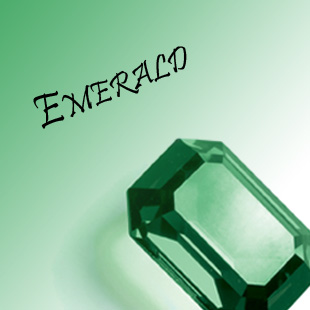https://dmnes.wordpress.com/2015/10/17/color-names-green/

Green is a curious color to consider its impact on the medieval European name pool as it (like orange and purple) is one of those colors that wasn’t clearly differentiated from others, and that many languages do not have words that differentiate ‘green’ from, e.g., ‘blue’ [1,2,3]. So it is not surprising that we have few names which derive from words for ‘green’: What is surprising is that we have two candidates of wholly different origin.

The first name we consider in this context is Emerald, a rare gemstone name appearing in 16th C France (as the name of a Florentine woman living in Lyon). The root Latin word, smaragdos, originally referred to any green precious stone, not only emeralds but also beryl and jasper, and the word continued to be ambiguous medievally. In the King James translation of the Bible, emerald is used as a translation of Hebrew nōphek, Greek ἄνθραξ, Vulgate carbunculus ‘carbuncle’, a type of gem not otherwise clearly identified [4].
While taking names from gemstones is a common pattern in modern English naming practices, names deriving from gems of any kind were rare in medieval Europe. This name therefore stands out as an unusual example, both for being a gemstone name and for the color it invokes.

The other name we can discuss under the color ‘green’ also derives from a Latin word, also is rare, and also was used in Italian contexts: Viridis, identical to a Latin word meaning ‘fresh, green; blooming, youthful’. Here ‘green’ is used more metaphorically than literally, but this is the word that gave rise to the color term for ‘green’ in many Romance languages, e.g., French vert, Italian, Portuguese, Spanish verde.
—
References:
[1] Delwin T. Lindsey & Angela M. Brown, “Color Naming and the Phototoxic Effects of Sunlight on the Eye”, Psychological Science 13, no. 6 (2002): p. 506.
[2] Paul Kay, “Color”, Journal of Linguistic Anthropology 9, nos. 1/2 (1999): p. 34.
[3] Heidi A. Lazar-Meyn, “Color Naming: ‘Grue’ in the Celtic Languages of the British Isles”, Psychological Science 15, no. 4 (2004): p. 288.
[4] “emerald, n.” OED Online. Oxford University Press, September 2015. http://www.oed.com/

Green is a curious color to consider its impact on the medieval European name pool as it (like orange and purple) is one of those colors that wasn’t clearly differentiated from others, and that many languages do not have words that differentiate ‘green’ from, e.g., ‘blue’ [1,2,3]. So it is not surprising that we have few names which derive from words for ‘green’: What is surprising is that we have two candidates of wholly different origin.

The first name we consider in this context is Emerald, a rare gemstone name appearing in 16th C France (as the name of a Florentine woman living in Lyon). The root Latin word, smaragdos, originally referred to any green precious stone, not only emeralds but also beryl and jasper, and the word continued to be ambiguous medievally. In the King James translation of the Bible, emerald is used as a translation of Hebrew nōphek, Greek ἄνθραξ, Vulgate carbunculus ‘carbuncle’, a type of gem not otherwise clearly identified [4].
While taking names from gemstones is a common pattern in modern English naming practices, names deriving from gems of any kind were rare in medieval Europe. This name therefore stands out as an unusual example, both for being a gemstone name and for the color it invokes.

The other name we can discuss under the color ‘green’ also derives from a Latin word, also is rare, and also was used in Italian contexts: Viridis, identical to a Latin word meaning ‘fresh, green; blooming, youthful’. Here ‘green’ is used more metaphorically than literally, but this is the word that gave rise to the color term for ‘green’ in many Romance languages, e.g., French vert, Italian, Portuguese, Spanish verde.
—
References:
[1] Delwin T. Lindsey & Angela M. Brown, “Color Naming and the Phototoxic Effects of Sunlight on the Eye”, Psychological Science 13, no. 6 (2002): p. 506.
[2] Paul Kay, “Color”, Journal of Linguistic Anthropology 9, nos. 1/2 (1999): p. 34.
[3] Heidi A. Lazar-Meyn, “Color Naming: ‘Grue’ in the Celtic Languages of the British Isles”, Psychological Science 15, no. 4 (2004): p. 288.
[4] “emerald, n.” OED Online. Oxford University Press, September 2015. http://www.oed.com/
No comments:
Post a Comment